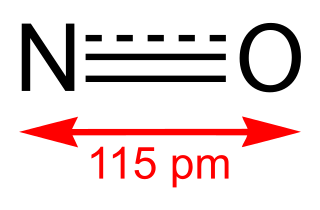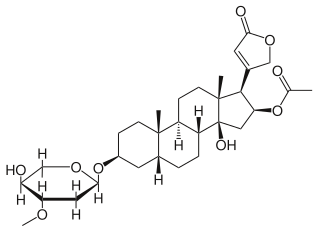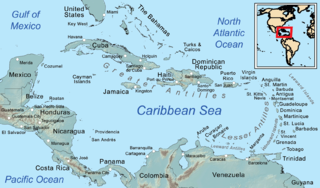A chemical formula is a way of presenting information about the chemical proportions of atoms that constitute a particular chemical compound or molecule, using chemical element symbols, numbers, and sometimes also other symbols, such as parentheses, dashes, brackets, commas and plus (+) and minus (−) signs. These are limited to a single typographic line of symbols, which may include subscripts and superscripts. A chemical formula is not a chemical name, and it contains no words. Although a chemical formula may imply certain simple chemical structures, it is not the same as a full chemical structural formula. Chemical formulas can fully specify the structure of only the simplest of molecules and chemical substances, and are generally more limited in power than are chemical names and structural formulas.
Hydrogen peroxide is a chemical compound with the formula H
2O
2. In its pure form, it is a pale blue, clear liquid, slightly more viscous than water. Hydrogen peroxide is the simplest peroxide. It is used as an oxidizer, bleaching agent and antiseptic. Concentrated hydrogen peroxide, or "high-test peroxide", is a reactive oxygen species and has been used as a propellant in rocketry. Its chemistry is dominated by the nature of its unstable peroxide bond.

Sulfuric acid (alternative spelling sulphuric acid), also known as vitriol, is a mineral acid composed of the elements sulfur, oxygen and hydrogen, with molecular formula H2SO4. It is a colorless, odorless, and syrupy liquid that is soluble in water, in a reaction that is highly exothermic.

Nitric oxide is a colorless gas with the formula NO. It is one of the principal oxides of nitrogen. Nitric oxide is a free radical, i.e., it has an unpaired electron, which is sometimes denoted by a dot in its chemical formula, i.e., ·NO. Nitric oxide is also a heteronuclear diatomic molecule, a historic class that drew researches which spawned early modern theories of chemical bonding.

Iron oxides are chemical compounds composed of iron and oxygen. All together, there are sixteen known iron oxides and oxyhydroxides.

In chemistry, neutralization or neutralisation is a chemical reaction in which an acid and a base react quantitatively with each other. In a reaction in water, neutralization results in there being no excess of hydrogen or hydroxide ions present in the solution. The pH of the neutralized solution depends on the acid strength of the reactants. Neutralization is used in many applications.

The brahminy myna or brahminy starling is a member of the starling family of birds. It is usually seen in pairs or small flocks in open habitats on the plains of the Indian subcontinent.
The Brønsted–Lowry theory is an acid–base reaction theory which was proposed independently by Johannes Nicolaus Brønsted and Thomas Martin Lowry in 1923. The fundamental concept of this theory is that when an acid and a base react with each other, the acid forms its conjugate base, and the base forms its conjugate acid by exchange of a proton (the hydrogen cation, or H+). This theory is a generalization of the Arrhenius theory.

Solar irradiance (SI) is the power per unit area received from the Sun in the form of electromagnetic radiation in the wavelength range of the measuring instrument. The solar irradiance integrated over time is called solar irradiation, insolation, or solar exposure. However, insolation is often used interchangeably with irradiance in practice.
Articles in economics journals are usually classified according to the JEL classification codes, a system originated by the Journal of Economic Literature. The JEL is published quarterly by the American Economic Association (AEA) and contains survey articles and information on recently published books and dissertations. The AEA maintains EconLit, a searchable data base of citations for articles, books, reviews, dissertations, and working papers classified by JEL codes for the years from 1969. A recent addition to EconLit is indexing of economics-journal articles from 1886 to 1968 parallel to the print series Index of Economic Articles.

Bezitramide is an opioid analgesic. Bezitramide itself is a prodrug which is readily hydrolyzed in the gastrointestinal tract to its main metabolite, despropionyl-bezitramide. Bezitramide was discovered at Janssen Pharmaceutica in 1961. It is most commonly marketed under the trade name Burgodin.

snoRNA U42 is a non-coding RNA (ncRNA) molecule which functions in the modification of other small nuclear RNAs (snRNAs). This type of modifying RNA is usually located in the nucleolus of the eukaryotic cell which is a major site of snRNA biogenesis. It is known as a small nucleolar RNA (snoRNA) and also often referred to as a guide RNA.

Peruvoside is a cardiac glycoside for heart failure.

Thevetia is a genus of flowering plants in the dogbane family, Apocynaceae, first described for modern science as a genus in 1758. It is native to Mexico, Central America, South America, and Cuba. The taxonomy of the genus is controversial, with some authors including Cascabela within Thevetia, while others accept the two genera as separate.

Oleandrin is a toxic cardiac glycoside found in oleander. Along with neandrin it is primarily responsible for the toxicity of the sap of oleander. Oleandrin has been used for many years in China and Russia for its properties as a cardiac glycoside, for both suicidal and therapeutic purposes as in treatment of cardiac insufficiency.














